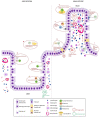Enteric Viruses and Inflammatory Bowel Disease
- PMID: 33451106
- PMCID: PMC7828589
- DOI: 10.3390/v13010104
Enteric Viruses and Inflammatory Bowel Disease
Abstract
Inflammatory bowel diseases (IBD), including ulcerative colitis (UC) and Crohn's disease (CD), is a multifactorial disease in which dietary, genetic, immunological, and microbial factors are at play. The role of enteric viruses in IBD remains only partially explored. To date, epidemiological studies have not fully described the role of enteric viruses in inflammatory flare-ups, especially that of human noroviruses and rotaviruses, which are the main causative agents of viral gastroenteritis. Genome-wide association studies have demonstrated the association between IBD, polymorphisms of the FUT2 and FUT3 genes (which drive the synthesis of histo-blood group antigens), and ligands for norovirus and rotavirus in the intestine. The role of autophagy in defensin-deficient Paneth cells and the perturbations of cytokine secretion in T-helper 1 and T-helper 17 inflammatory pathways following enteric virus infections have been demonstrated as well. Enteric virus interactions with commensal bacteria could play a significant role in the modulation of enteric virus infections in IBD. Based on the currently incomplete knowledge of the complex phenomena underlying IBD pathogenesis, future studies using multi-sampling and data integration combined with new techniques such as human intestinal enteroids could help to decipher the role of enteric viruses in IBD.
Keywords: Crohn’s disease; adenovirus; aichi virus; astrovirus; inflammatory bowel disease; norovirus; rotavirus; sapovirus; ulcerative colitis.
Conflict of interest statement
The authors declare no conflict of interest.
Figures

References
-
- Alatab S., Sepanlou S.G., Ikuta K., Vahedi H., Bisignano C., Safiri S., Sadeghi A., Nixon M.R., Abdoli A., Abolhassani H., et al. The Global, Regional, and National Burden of Inflammatory Bowel Disease in 195 Countries and Territories, 1990–2017: A Systematic Analysis for the Global Burden of Disease Study 2017. Lancet Gastroenterol. Hepatol. 2020;5:17–30. doi: 10.1016/S2468-1253(19)30333-4. - DOI - PMC - PubMed
Publication types
MeSH terms
Substances
LinkOut - more resources
Full Text Sources
Other Literature Sources

